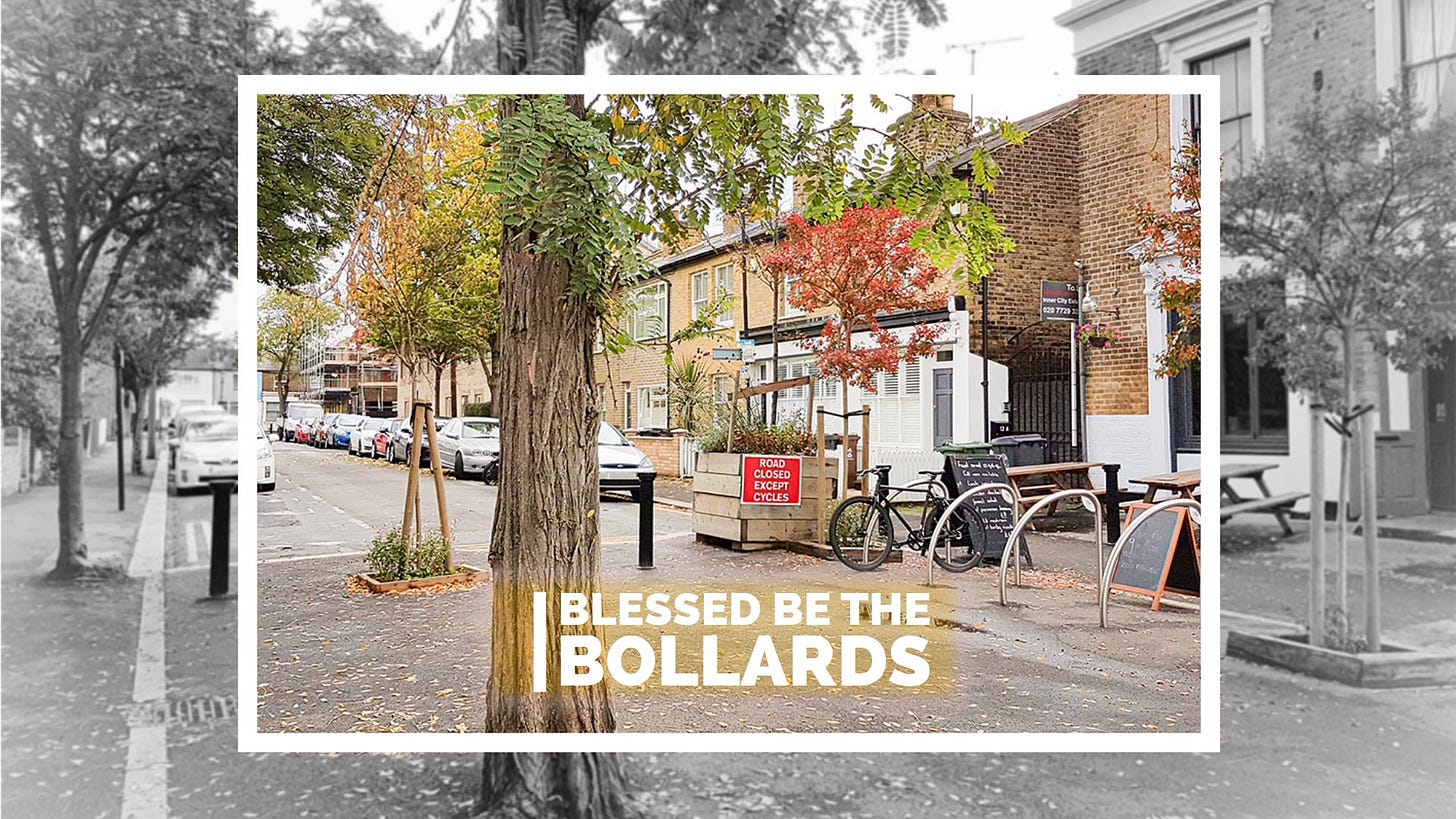“Around 15% of displaced traffic disappears from the area entirely as drivers adjust routes and behaviour.” – Living Streets
Name: LTNs (Low Traffic Neighbourhoods)
Appearance: Planters, bollards and other interventions – modal filters – that prevent motor vehicles from accessing certain streets to prevent rat-running. The aim is to make residential areas more conducive to walking and cycling. Make places safer and ideally ensure all the shops and facilities you need are within a 15-minute walk of your house.
Ah! The 15-minute city! You want to stop us leaving our street without a Visa! Not really. I’m just lazy and like the idea of being able to walk a short distance to the places I need to go.
I’m not convinced. How long have they been around, exactly? Since the 60’s. In Primrose Hill, London, two bollards were installed on Regent’s Park Road to prevent vehicles accessing the railway bridge following the death of two children on the roads. As a result, through traffic was prevented.
Oh. So they’ve been around for quite a while then? Absolutely and before the Covid outbreak there were about 25,000 modal filters in place across the UK… and pretty much no-one said a word about them.
That’s a lot of filters! So Covid changed all that? It did. In May 2020 local highway authorities were given powers to rapidly introduce LTNs to help people walk and cycle and socially distance.
That sounds like a good idea given we could only leave the house for an hour. And it was! But there’s always been a backlash against them, which you seem to contribute to and, recently, an LTN set up in Lambeth got the Council into trouble.
Ooh, really? What happened? The council was found to have acted unlawfully by the High Court for failing to take account of a 53-page dossier citing issues with the scheme.
Uh-oh. Now what? Well, the LTN will stay in place while Lambeth council reviews the decision. Many criticisms of LTN’s – that traffic will be pushed onto adjacent roads, causing chaos, or that emergency vehicles won’t be able to attend incidents, causing chaos, or that Waitrose deliveries won’t get through, causing chaos… don’t seem to stack up.
What do you mean? The traffic has got to go somewhere. Well, Rishi Sunak’s (remember him?) 2024 review of LTN’s, which was produced in response to the “war on the motorist” ultimately discovered that 45% of respondents supported the schemes, 21% opposed them and 58% didn’t even know they lived in an LTN. The fanfare that accompanied the launch of the review went very quiet very quickly.
Hmm. I bet it did. Anything else to champion LTN’s? Well, there’s the increase in active travel and the reduction in air pollution, lower injury rates, decreases in street crime, violent crime and sexual assaults.
So, good news for women and vulnerable people living in LTN’s then? Indeed. Something that actively reduces sexual and violent crime has got to be a good thing! If you recall, our conversation started over a comment on a chat show about women carrying their phones at the ready in order to defend themselves if they had to.
I do. So, while LTN’s aren’t the only answer to street crime, they are helping. That’s something I can get behind.
#MeToo! Absolutely nothing bad about LTN’s then? Well, apparently there was an increase in bicycle theft.
Ah. Not so good. No. But if you think about the fact that five people die on the roads in the UK EVERY DAY, anything that reduces the risk of collisions by encouraging more walking and cycling instead of driving has got to be a good thing. If five people were being killed on public transport every day there’d be an outcry, it’d be all over the news. But road violence is now so normalised we’re happy to live with five families having their lives turned upside down on a daily basis.
I agree. Motonormativity has gone mad. What can we do? Well, I like Izzy Romilly’s take on it, that:
“… the substance of the backlash against LTNs is often not so much about the LTN itself, but a reaction against unreliable or nonexistent buses, high fares, poor accessibility or overcrowded roads – all of which need fixing, and none of which would be solved by scrapping LTNs. Priority bus lanes, wider pavements, clean air zones, 20mph limits, cycle lanes and phasing out diesel – as well as meaningful engagement with residents – could all help address these concerns, stop traffic or pollution from rising, and give people more choice in how they get around.”
All good suggestions if we can get the people at city hall and the bus operators on board. I’m starting to come round to this. LTN’s are here to stay then? I think so, they’re still way more helpful than not. But people should stop attacking the bollards. They have feelings too.
That’s awful. It is. I’m sure the World Bollard Association would have something to say about it. Mess with bollards at your peril!
Do say: And while we’re about it, let’s have more school streets!
Don’t say: But how will Waitrose deliver my Duchy Organic Extra Virgin Olive Oil and avocados now?
Question: Should new major housing developments – and the government’s proposed new towns – be designed to LTN standards as the default?
#LTN #LTNs #bollards #MeToo #Lambeth #motonormativity #waronthemotorist #15minutecity




